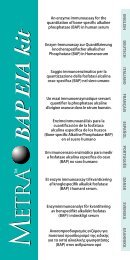Clinical and Technical Review - Tecomedical
Clinical and Technical Review - Tecomedical
Clinical and Technical Review - Tecomedical
You also want an ePaper? Increase the reach of your titles
YUMPU automatically turns print PDFs into web optimized ePapers that Google loves.
2<br />
Bone turnover Biomarker in<br />
Osteoporosis<br />
Diagnosis of metabolic bone diseases can be established<br />
by measuring bone mineral density (BMD) at the hips or spine.<br />
However, BMD is a static measure of bone composition,<br />
reflecting its history. A baseline BMD value does not offer<br />
any prediction of future bone loss or response to therapy.<br />
Moreover, since biochemical bone marker reflect the wholebody<br />
rates of bone turnover, the combined measurement of<br />
bone marker <strong>and</strong> BMD provides more information on the<br />
overall bone loss than BMD measurement at specific skeletal<br />
sites alone.<br />
The increasing number of drugs available for treatment of<br />
osteoporosis <strong>and</strong> other bone diseases requires the use of<br />
more rapid <strong>and</strong> predictive methods to assess therapy efficacy.<br />
While detectable <strong>and</strong> significant changes in BMD take 18 to<br />
24 months to develop, bone turnover marker have been<br />
shown to detect changes in bone tissue within 3-6 months<br />
after starting anti-resorptive therapy. Therefore, measurement<br />
of bone turnover marker is increasingly recommended<br />
as a key component of therapy management: to rapidly<br />
identify therapy responders <strong>and</strong> non-responders, to assess<br />
therapy efficacy <strong>and</strong> to determine the optimal therapy <strong>and</strong><br />
dose of treatment.<br />
Bone marker are intended for use as an<br />
aid in:<br />
• management of postmenopausal osteoporosis <strong>and</strong><br />
Paget’s disease;<br />
• monitoring of postmenopausal women on hormonal<br />
or bisphosphonate therapy;<br />
• prediction of skeletal response to hormonal therapy<br />
in postmenopausal women.<br />
• Detection <strong>and</strong> monitoring of Bone metastasis.<br />
Biomarker <strong>and</strong> Cartilage Destruction<br />
Degenerative joint disease such as osteoarthritis (OA) <strong>and</strong><br />
rheumatoid arthritis (RA) are major causes of disability <strong>and</strong><br />
impaired quality of life among the elderly. Despite better<br />
underst<strong>and</strong>ing of the underlying pathomechanisms, current<br />
clinical practice for diagnosing these diseases mainly relies<br />
on symptom assessment, which has limited sensitivity <strong>and</strong><br />
specificity. By the time radiological techniques can reveal<br />
specific sign, the disease has advanced to a late phase with<br />
pronounced structural damage, when the only therapeutical<br />
option remaining is joint replacement. As marker provide a<br />
dynamic measure of current degradation rate in contrast to<br />
radiological investigations, they allow a rapid determination<br />
of the therapeutic effects, <strong>and</strong> they may also be used for<br />
selecting the therapies <strong>and</strong> drug dose, which are most efficient.<br />
In the lack of established diagnostic methods allowing<br />
the detection of cartilage degradation, early diagnosis<br />
<strong>and</strong> disease monitoring remain a major challenge of health<br />
care professionals.<br />
Therefore Biochemical marker for Cartilage degradation <strong>and</strong><br />
synthesis are helpful for the management of Rheumatoid<br />
Arthritis <strong>and</strong> Osteoarthritis.<br />
Biomarker for diagnosing skeletal<br />
metastases<br />
Cancers have the ability to metastasize to organs distant<br />
from the site of the primary tumor. Breast, prostate,<br />
<strong>and</strong> lung cancer are primary tumors that most frequently<br />
metastasize to the skeleton. The chronic presence of bone<br />
metastasis often results in complete pathologic remodeling<br />
of the affected bone compartment, making affected bones<br />
vulnerable to several complications. Such complications<br />
include pathologic fractures, spinal cord compression,<br />
hypocalcemia, <strong>and</strong> severe bone pain. All reducing quality of<br />
life <strong>and</strong> worsening prognosis. Therefore, early diagnosis <strong>and</strong><br />
adequate treatment of bone metastasis is critically important<br />
for the clinical management of cancer patients.<br />
Emerging evidence suggests that biomarker of bone<br />
turnover carry notable potentials to become useful<br />
diagnostic tools for the diagnosis of bone metastases.<br />
The study by Leeming et al was sought to assess the<br />
relative use of eight biomarker for the detection of bone<br />
metastases in cancer forms frequently spreading to the skeleton.<br />
Participants were 161 patients with either breast, prostate,<br />
or lung cancer. The presence <strong>and</strong> extent of<br />
bone metastases was assessed by imaging techniques<br />
(computer tomography <strong>and</strong>/or magnetic resonance<br />
imaging) <strong>and</strong> Technetium-99m scintigraphy. Number of<br />
bone metastases was recorded, <strong>and</strong> the skeletal load was<br />
graded, as previously proposed by Soloway. The Serum<br />
or urinary level of the bone resorption marker (alpha-CTX,<br />
beta-CTX, NTX, <strong>and</strong> ICTP), formation marker (BSAP),<br />
<strong>and</strong> osteoclastogenesis marker (osteoprotegerin, RANKL,<br />
<strong>and</strong> TRAP5b) was measured by commercially available<br />
immunoassays. There was a uniform pattern of significantly<br />
increased levels of the resorption marker in patients with<br />
bone metastases compared with those without.<br />
The relative responsiveness of marker was calculated to<br />
obtain insights into the relative sensitivity of the different<br />
marker to signal skeletal involvement. The plot demonstrates<br />
a trend toward greater relative increases in the level of the<br />
urine alpha-CTX <strong>and</strong> serum BSAP marker compared with<br />
other marker; differences becoming more evident with<br />
increasing Soloway score.


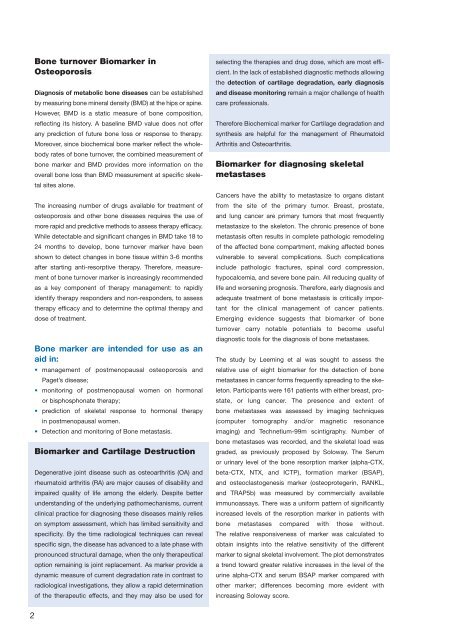
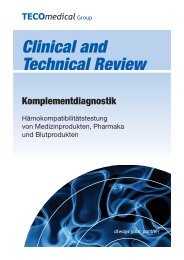
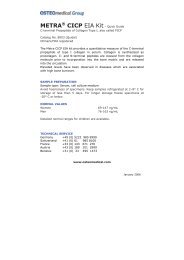
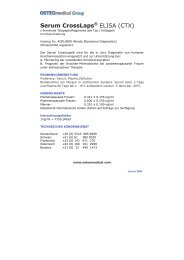
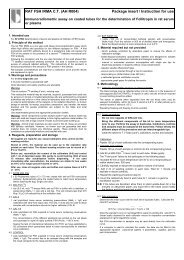


![PTH [Hormone Parathyroïdienne] Intacte ELISA](https://img.yumpu.com/1233682/1/190x245/pth-hormone-parathyroidienne-intacte-elisa.jpg?quality=85)
